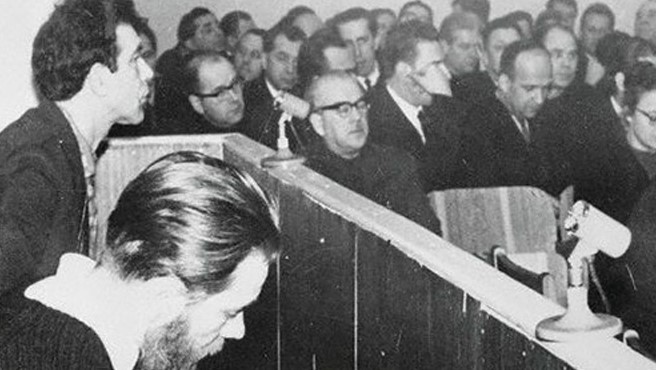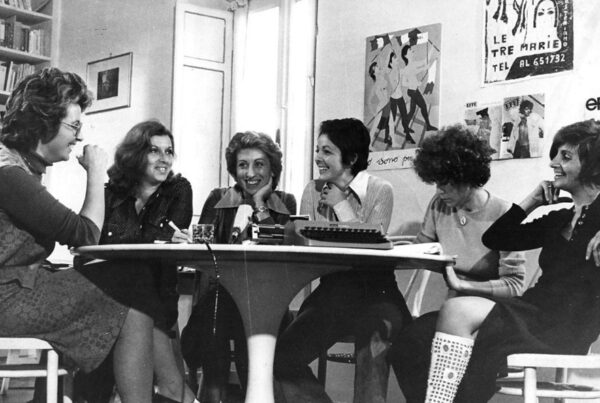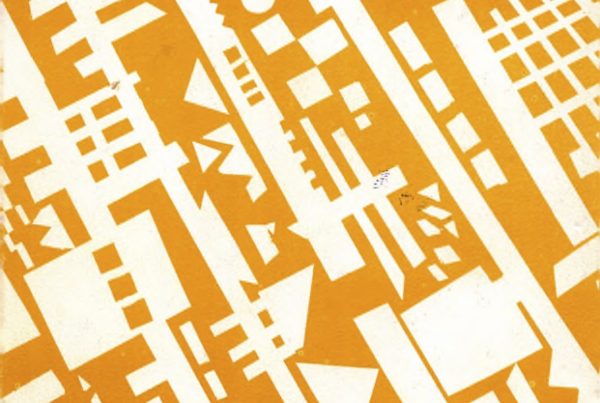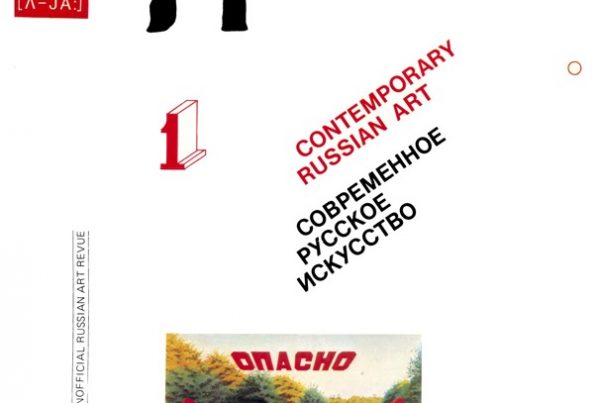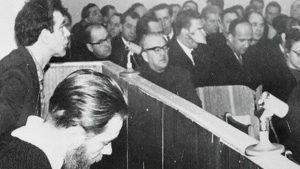
The writers Andrei Siniavskii and Iulii Daniėl’ on trial. Moscow, February 1966.
Title:
Belaia kniga po delu Siniavskogo-Daniėlia [White Book on the Siniavskii-Daniėl’ case]
Author: Aleksandr Ginzburg
Years of editing: 1965-1967
Year of first publication: 1967 (German, Italian, Russian)
Publishing house: Posev (Frankfurt), Jaca Book (Milan)
First edition in Russian: 1967 (Posev)
Description:
“Clandestine literature, i.e. that which does not have access to official publication, beginning with the writers of the 1920s and ending with the works of A. Siniavskii and Iu. Daniel’ has a very important and exclusive value in our national culture” (Galanskov 1967: 78).
The White Book on the Siniavskii-Daniėl’ case was written and edited clandestinely by the dissident intellectual Aleksandr Ginzburg in the years 1965-1966, during and right after the dramatic judicial events involving the writers Iulii Daniėl’ and Andrei Siniavskii. The writers were accused, tried and sentenced to prison for having published a number of works abroad, under the pseudonyms Nikolai Arzhak and Abram Terts, which were considered to be in conflict with the aesthetic doctrines of socialist realism and tainted with anti-Soviet propaganda.
During the trial, presided over by Judge Smirnov, the two writers were called upon to defend themselves against the charge of having violated Article 70 of the Criminal Code of the RSFSR (anti-Soviet agitation and propaganda). In particular, they were accused of failing to include the figure of a ‘positive hero’ in their novels, which was a compulsory element of Soviet literature according to the canons of socialist realism. For the regime, the role of the hero was to instil confidence and optimism in the reader-worker and perform a pedagogical-illustrative function to guide citizens by presenting absolute visions of good and evil.
According to the testimony of Natal’ia Gorbaneveskaia (in the work Polden’), the title of the White Book was bestowed on Ginzburg’s collection of materials by the KGB. To the insistent questions of the agents who searched her flat on the day of her arrest for taking part in the protest demonstration in Red Square in support of the uprising in Czechoslovakia in 1968, Gorbaneveskaia replied: “He simply called it: collection of documents on the Siniavskii and Daniėl’ case (…) I have already explained that he did not title it so, but the KGB. Go and ask the KGB (…) – We are not the KGB!” (Gorbanevskaia 1979: 94). The book was in fact originally called Delo Siniavskogo i Daniėlia.
Ginzburg’s book is a collection of documents, testimonies and transcripts of the trial that were circulated in the samizdat thanks to the wives of the defendants, Mariia Rozanova and Larisa Bogoraz, and acquaintances who did their best to spread non-official news about proceedings. Ginzburg made great efforts to collect extensive documentary material in order to obtain a broad overview of the case. The work consists of three main parts, arranged chronologically: the first deals with the series of events after the defendants were arrested, the second focuses on the trial itself and the third contains documents relating to events after the trial; each section presents a detailed index of the documents collected, with references to the respective pages.
After a brief account informing the reader about the arrests of Siniavskii and Daniėl’, the first part, which comprises about half of the volume’s pages, includes numerous newspaper headlines and excerpts from newspaper articles. Ginzburg collected some of the most significant reactions from the press all over the world, including those of the “Washington Post”, “Le Monde”, “New Leader” and “L’Espresso”. The headlines express indignation and dismay at the arrests, considered by many as a serious infringement of freedom of speech. The reader is then briefly informed about the personalities of the accused and their activities in Soviet literature, through a series of letters and dedications from friends and comrades, including a letter written by Boris Pasternak to Siniavskii, as well as letters and articles written by detractors. This first part concludes with letters and appeals signed by important figures of Soviet society sent to the Legal Council, the Moscow Tribunal and the Supreme Court of the Russian Soviet Socialist Federal Republic asking that the accused be acquitted. These include a letter written by the art critic Galamshtok, which asserts that “the problems he [Siniavskii] raises, the fracture between the individual and society, the contradiction between the growth of technical progress and the spiritual impoverishment of man, the relationship between objectives and the means of achieving them are at the heart of contemporary culture” (Ghinsburg 1967: 146).
The second part deals specifically with the trial itself and the verdict. Ginzburg gives information about where the trial took place, the condition of the defendants, the defence lawyers, the charges and the questions asked of the defendants in court. The events of the trial are introduced by a transcript of a recording of the courtroom interrogation of IuliI Daniėl’ and accounts in the Soviet press on the first day of the trial, which is followed by the transcript of the recording of the courtroom interrogation of Siniavskii on the second day of the trial and the press accounts of the second day.
The third and final part of the book is entitled After the Trial. It opens with two documents, the first a letter to the editorial board of the Soviet journal “Literaturnaia Gazeta” from a group of professors, and the second the report of the Session at the Secretariat of the Moscow Section of Russian Writers, both of which accuse and condemn the defendants without hesitation as “slanderers”. Further letters and statements against the accused, some of which are introduced by a personal comment by Ginzburg, are reproduced. The last document (n.174) is a letter which in Ginzburg’s opinion expresses “the attitude of the intelligentsia” (Ghinsburg 1967: 86). The author’s name, Iurii Galanskov, was expunged from this published version of the letter (probably to deflect the consequences that he would have suffered in the USSR once it appeared in tamizdat), which was given the title, Letter to an old friend. However, a signed version of the letter appeared at the same time, in the samizdat review Feniks ’66, and was then included in a sylloge of contributions from the same magazine, which was published in Italian, again by Jaca Book, the following year (cf. Galanskov 1968: 63-86). This open letter was courageously addressed by Galanskov to the then highly acclaimed Soviet writer M. Sholokhov (Nobel Prize winner for Literature in 1965), to the Union of Soviet Writers, and to the editors of soviet literary Journals such as “Novyi Mir” and “Literaturnaia gazeta”. The letter presents a virulent attack on the cultural establishment and its misrepresentation of clandestine culture and literature in the USSR. It opens by comparing the trial of Siniavskii and Daniėl’ with those that took place in the 1930s during the Stalinist terror. The author argues that the trial of Siniavskii and Daniėl’ represents a crucial turning point in the history of Soviet dissent as for the first time during a public political trial the accused, from beginning to end, never pleaded guilty and did not remain in silence before the regime’s accusations. It is true, that this was the first trial against Soviet writers in which the defendants managed to counter their accusers by arguing that there is a distinction between the artistic-literary space and the judicial space: in other words, the aesthetic and ideological autonomy of the artist and his works should be evaluated only according to the principles of art (Siniavskii declared to the court: “in the depths of my soul I believe that literature should not be approached with legal formulas”, Ghinsburg 1967). The writers did not defend their works by claiming that, despite accusations, they did in fact ascribe to the dictates of socialist realism. Rather, they argued, provocatively, that a work was separate from the person who created it, and, at the same time, implicitly criticised the Soviet system (in particular its ‘anthropopoetical’ vision) with recourse to aesthetic, literary and socio-cultural analyses that explored the status of literature and art in society. The writers thus used the trial not only to defend themselves from the specific accusations levelled against them, but also to defend clandestine culture from the repressively rigid Soviet view of creative expression.
Ginzburg’s White Book provides the reader with comprehensive information about the Siniavskii-Daniėl’ case, as well as about the reactions that it aroused internationally and the general condition of the Soviet Union at the time. The collection is not only addressed to Soviet citizens, but to anyone who wants to find out about the case: Ginzburg was fanatical about gathering as much information as possible and his comments act as a guide for the reader. The last pages of the book contain 144 notes on the names of people, acronyms, magazines etc. mentioned in the book.
Ginzburg grasped the importance of this trial and, well aware of the risks he was incurring, devoted himself to diffusing reliable information about it in countries outside the USSR, in particular in Western Europe, making his book a symbol of the tamizdat phenomenon and the expression of Dissent in these years.
Ginzburg sent a copy of the work to Frankfurt am Main, where it was first published in Russian (Belaia kniga po delu Siniavskogo i Daniėla) and immediately afterwards in a German translation (Weissbuch) in 1967, by the famous tamizdat publishing house Posev. The first Italian translation of The White Book on the Siniavskii-Daniėl’ Case, by Sergio Rapetti (under the pseudonym Nicola Sorin), was published in Milan by Jaca Book, and came out in the same year as the first tamizdat edition in Germany (Posev). The commitment of Jaca Book to disseminating the works of dissenting Soviet authors in Italy, especially in the 1960s and 1970s is indisputable. The previous year the publishing house had printed the chrestomathy Riviste clandestine dell’Unione sovietica (Clandestine magazines in the Soviet Union) and in 1968, after the White Book, it published the Italian version of the second issue of “Feniks 66“, whose editor-in-chief was Iu. Galanskov. In 1979, Jaca Book published several of the typewritten magazines of the 1960s including The Moscow Spring: Soviet Typewritten Magazines of the 1960s: Prose, Poetry, Civil Commitment at the Beginnings of Dissent (ed. Bukovskii et al. Milan, Jaca Book, 1979) as well as other titles on silenced, proscribed or censored literature from the USSR.
The tamizdat in Italy was certainly active – the very first edition of Doktor Zhivago was published in Milan – but the case of the White Book is interesting since Siniavskii was one of the very few dissident figures who came to Italy as an exile (cf. Mal’tsev 2015). As Mal’tsev asserted, Siniavskii could not have been ignored by the Italian intelligentsia, because his books had been published and circulated in Italy (under the pseudonym A. Terts) and the trial had also aroused debate and interest in journals which looked “beyond the iron curtain” such as Tempo Presente, co-edited by the famous Italian writer I. Silone.
Before the first full Italian edition of the White Book was published, excerpts from the documents contained in the work had already been sent to the magazine “Tempo presente“, which had published them in 1966 (cf., for example, Documenti. In defence of Siniavski, with an introduction by G. Herling, “Tempo presente”, 1966 (XI), 12, pp. 75-8, which reproduces the Letter of the art critic I. Golomshtok to the Supreme Court of the Russian Republic – early February 1966, cf. Ghinsburg 1967: 145-151). “Tempo presente” took a militant stance in defending Soviet dissenters and had given the Siniavskii-Daniėl’ case significant attention even before the White Book came out in Italy. In February 1966, it had published several reports on the trial (cf. Herling 1966: 2-4; Silone 1966: 4-6; Anonimo 1966: 6-7), which were widely read by Italian intellectuals, meaning that when Ginzburg’s work came out, its context was already understood by many of its readers. Following these first almost simultaneous Tamizdat editions, the book was circulated in other European countries and was translated into English and French.
It was thanks to tamizdat circuits that information about the trial of Andrei Siniavskii and Iulii Daniėl’ became available, so that anyone interested in the case could gain objective documentation of the facts. In the USSR, information about the case was mediated by newspapers closely linked to the Soviet regime, which did not provide reliable details about the indictments and the way the trial was conducted (which is why the “Khronika Tekushchikh sobytii“ was so important). The official press did all it could to condition public opinion, and the two dissident writers were attacked in the pages of the major newspapers as “slanderers” and “traitors to the fatherland”. The chapter in Sinjavskii’s novel Goodnight! entitled Perevertyshi (Turncoats) became ironically autobiographical as it had the same title as the caustic article attacking the defendants written by the Soviet critic Eremin during the trial and published in “Izvestiia” on 12th January. During the 23rd conference of the CPSU in the same year Sholokhov, used the same term to refer to the two accused writers.
Most of the documents contained in Ginzburg’s work were published in the Soviet Union during perestroika, in 1989, in the collection Tsena metafory, ili Prestuplenie i nakazanie Siniavskogo i Daniėlia (The Price of Metaphor, or the Crime and Punishment of Siniavskii and Daniėl’), edited by E. Velinakov and published by The Book publishers in Moscow.
It is not easy to assess the impact of Ginzburg’s work in the West (in Italy, except for magazines such as “Tempo presente” the trial was only marginally covered in the press). However, it is certainly possible to discern the indirect effects of the European publication of the White Book in the Soviet Union. The book’s tamizdat editions favoured the formation of a critical attitude towards the regime and fueled the clandestine circulation of opinions counter to the official line, meaning that the author quickly became a target for retaliation by the authorities. In January 1968, the Moscow prosecutor’s office tried Ginzburg together with three other activists (Iu. Galanskov, A. Dobrovol’skii and V. Lashkova) in what came to be known as “the trial of the four”. Ginzburg was accused of compiling and publishing a censored text abroad, involvement in the samizdat almanac Feniks 66 (cf. Chiaromonte 1968: 2-3) and promoting a demonstration against the arrest of comrade Galanskov (cf. Galanskov 1968: 11). He was sentenced to five years’ imprisonment in the special correction camps, the Khrushchev ‘gulags’, in Mordovia.
As Ginzburg had done for the trial against Siniavskii-Daniel’, the history, protagonists, and national and international resonance of his own trial were documented by P. Litvinov in the book Protsess cheterykh (Trial of the Four). Litvinov saw his work as a continuation of Ginzburg’s White Book (Litvinov 1971: 5) and despite some organisational differences (such as the biographical chapter on the “personalities of the defendants”, which was absent from Ginzburg’s book), the two works established a new genre of writing in independent literature and marked a new era of critical consciousness in the Soviet Union. The approach of the writer within this new genre is journalistic in its exposure of cases in which freedom of expression is denied. The writer, however, participates in the narrative, taking a clear stance on the first level material he presents, organising his narrative around objective, documented information, which is reconstructed from press extracts, appeals, open letters, correspondence, transcripts of interrogations and court hearings.
Claudia Pieralli
[30th June 2021]
Bibliography
- Anonimo, Cronaca. Una perdita per la libertà, “Tempo presente”, XI.2 (1966): 6-7.
- Chiaromonte N., I condannati di Mosca, “Tempo presente”, XIII.1 (1968): 2-3.
- Galanskov Ju., Rivista sovietica non ufficiale: Feniks 66, trans. into Italian by N. Sorin, Milano, Jaca Book 1968.
- Ghinsburg A., Libro Bianco sul caso Daniel-Sinjavskij, Jaca Book, Milano 1968.
- Ginzburg A., Aleksandr Ginzburg: da “Sintaksis” al “Gruppo Helsinki”, in G. Nissim (ed.), Storie di uomini giusti nei Gulag, Mondadori, Milano 2004: 175-185.
- Gorbanevskaia N., Polden’, Frankfurt, Posev 1970.
- Herling G., Cronaca. La condanna di Sinjavskij e Daniel, “Tempo presente”, XI.2 (1966): 2-4.
- Litvinov P. (ed.), Protsess chetyrekh. Sbornik materialov po delu Galanskogo, Ginzburga, Dobrovol’skogo i Lashkovoi, Seriia “Biblioteka Samizdata n.1”, Amsterdam, Fond im. Gerzena, 1971.
- Mal’tsev Iu., Sovetskie dissidenty v Italii, “Enthymema”, XII, 2015.
- Silone I., Intorno al processo, “Tempo presente”, XI.2 (1966): 4-6.
- Velinakov E., Tsena metafory, ili Prestuplenie i nakazanie Siniavskogo i Daniėlia, Moskva 1989.
Sitography
- http://antology.igrunov.ru/70-s/periodicals/process-4/, online (last accessed: 30/06/2021).
- http://antology.igrunov.ru/70-s/periodicals/white-book, online (last accessed: 30/06/2021).
- https://dissidenten.eu/laender/russland/biografien/alexander-ginsburg/, online (last accessed: 30/06/2021).
- https://www.lanuovaeuropa.org/personaggi-del-dissenso/2016/03/04/quel-ragazzo-che-lancio-il-samizdat/, online (last accessed: 30/06/2021).
- https://riviste.unimi.it/index.php/enthymema/article/view/4951/5013, online (last accessed: 30/10/2021).
To cite this article:
Claudia Pieralli, White Book on the Siniavskii-Daniėl’ case (A. Ginzburg), in Voci libere in URSS. Letteratura, pensiero, arti indipendenti in Unione Sovietica e gli echi in Occidente (1953-1991), a cura di C. Pieralli, M. Sabbatini, Firenze University Press, Firenze 2021-, <vocilibereurss.fupress.net>.
eISBN 978-88-5518-463-2
© 2021 Author(s)
Content license: CC BY 4.0
